Smart air purifiers have become increasingly popular in the market over time. More and more manufacturers are choosing to include innovative and smart options in their air purifiers. These features make day-to-day control easier, whether by fully automating the air purifier, connecting it to a voice assistant, or simply monitoring the current air quality in the room.
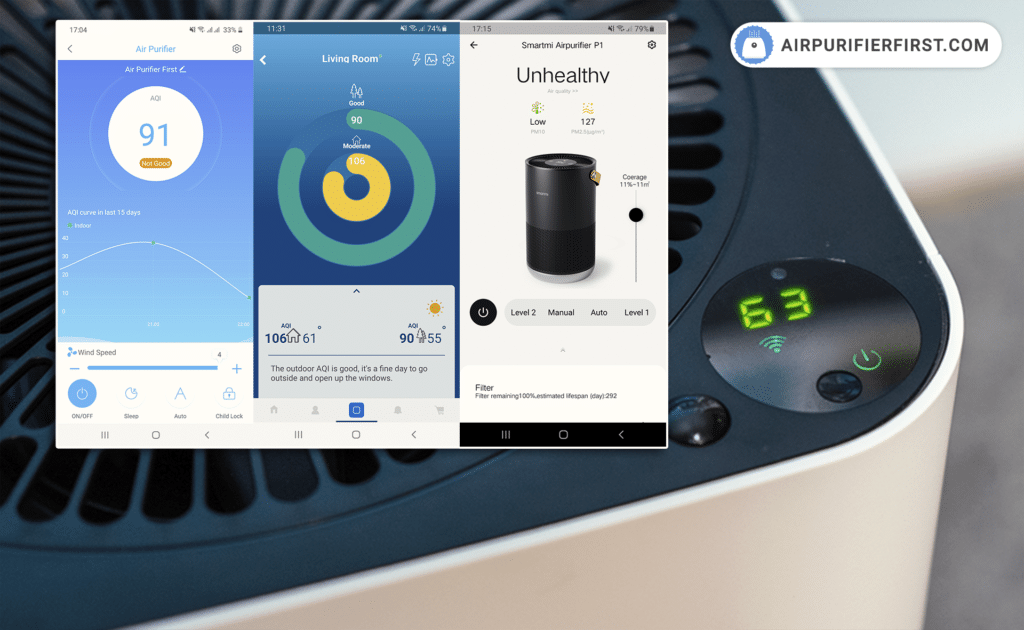
Table of Contents
- In a Hurry? Here’s a Quick Summary of the Best Smart Air Purifiers!
- Top 4 Smart Air Purifiers
- Levoit Vital 200S – Innovative & Easy To Use App
- Dyson TP02 – The Most Premium App
- Xiaomi 4 Compact – The Smartest App
- Smartmi P1 – With Pollen Detection
- What Makes an Air Purifier Smart?
- Choosing the Best Smart Air Purifier
- Advantages of a Smart Home Air Purifier
- FAQ on Best Smart Air purifiers
- Final Thoughts
Most importantly, smart air purifiers aren’t different from classic air purifiers. They are essentially the same but with additional smart features such as an air quality sensor, a smart app, or the ability to connect to a voice-controlled device (Alexa, HomeKit, Google Assistant, or similar). However, these features don’t determine what filtration technology an air purifier use.
From a personal perspective, I have seen the advantages that smart air purifiers have over non-smart ones. They can be easily customized, automated, and remotely controlled. These advanced devices offer many options and benefits that I have found very easy to get used to.
I have tested many different air purifiers, with varying power, filter technologies, and smart options. And, in this guide, I will explain in detail what smart air purifiers are, what features they have, what you can expect from such air purifiers, and, of course, I will list the best smart air purifiers you can buy.
In a Hurry? Here’s a Quick Summary of the Best Smart Air Purifiers!
- Levoit Vital 200S – This is the best smart air purifier. It works with the innovative VeSync app, has plenty of smart features, and is an overall well-performing air purifier.
- Dyson TP02 – A premium air purifier with plenty of smart features that work with the MyDyson app. It has the most accurate air quality sensor I have seen.
- Xiaomi 4 Compact – Works with the powerful Mi Home app, and features an air quality sensor, air quality indicator, and built-in auto mode. It is a great compact device.
- Smartmi P1 – Characterized by the air quality sensor that detects airborne pollen particles in addition to PM2.5 particles. It works with the Smartmi Link smart app.
*If you click any of these links and make a purchase, we earn a commission at no additional cost to you.
Top 4 Smart Air Purifiers
After a detailed analysis and consideration of which devices to include, I have compiled a list of the four best smart air purifiers that are also efficient and did well in tests.
Levoit Vital 200S – Innovative & Easy To Use App
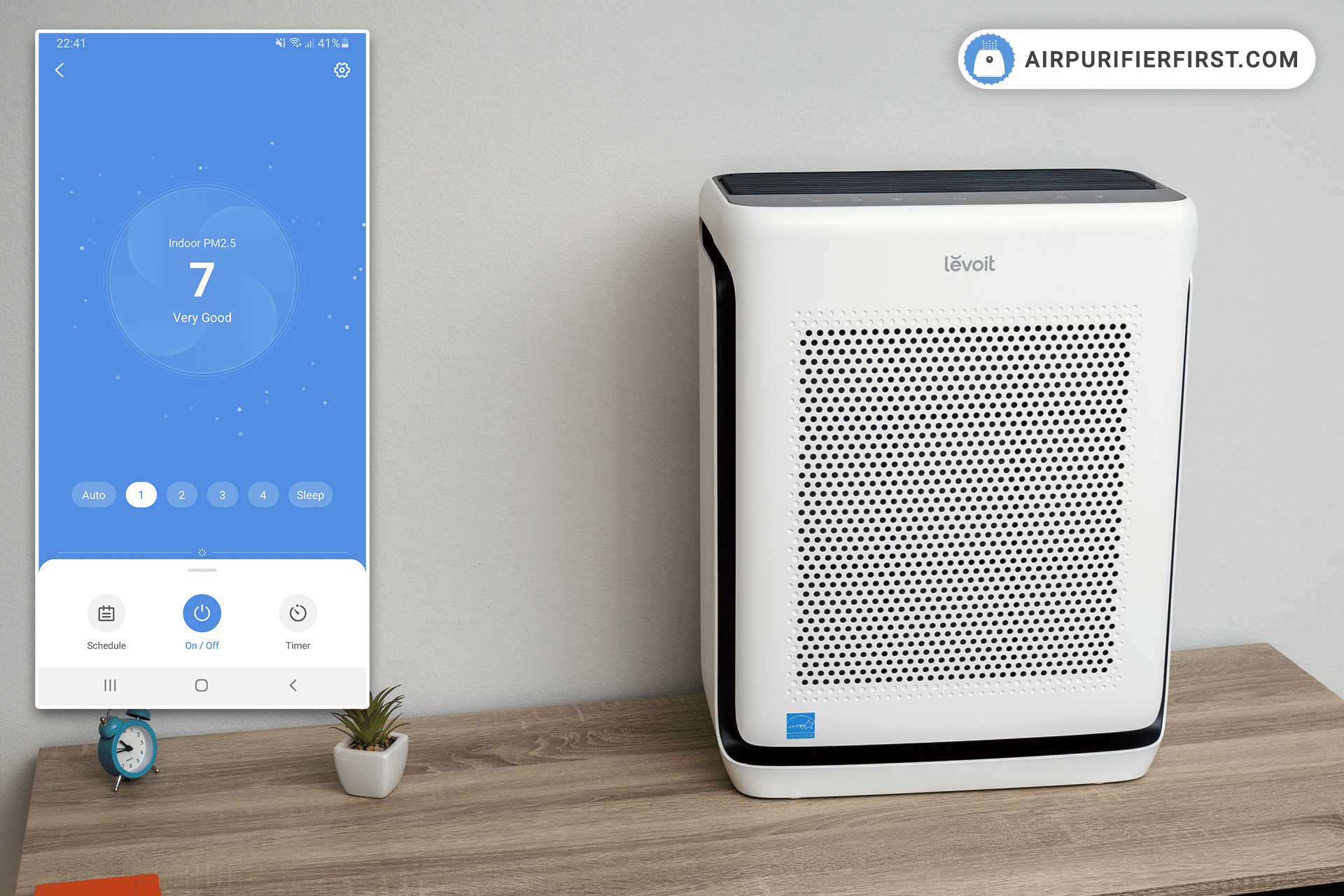
Levoit Vital 200S Keypoints
- The Levoit Vital 200S works with the VeSync smart app, an all-in-one app that makes the Vital 200S (and other Levoit air purifiers) one of the smartest devices on the market.
- It covers rooms up to 380 sq. ft. (35 m²), making it ideal for living rooms, bedrooms, kitchens, or similar areas.
- Among the smart features, I would highlight the air quality sensor, air quality indicator, auto mode, and smart app integration.
- The Vital 200S uses a three-stage filtration technology consisting of a washable pre-filter, a True HEPA filter, and an activated carbon filter.
- In a test in a 320 sq. ft. room, it improved air quality by 96% in just 60 minutes, working at maximum speed all the time.
The Levoit Vital 200S is the best smart air purifier you can get. It covers rooms up to 380 sq. ft. (35 m²) and cleans the air 4.8 times an hour in the recommended room size.
This air purifier uses the latest smart and innovative technology from Levoit. It features several built-in smart features, with the air quality sensor, air quality indicator, and auto mode being my favorites. The Vital 200S uses an infrared dust sensor that detects particles in real-time.
One of the most exciting smart features is the ability to connect the Vital 200S with the VeSync smart app. This app boosts your Vital 200S to a completely different level, unlocking many new possibilities that aren’t available through the physical controls on the device. The most notable features include detailed air quality reports, automation, remote control, smart notifications, filter life checks, auto mode settings, scheduling, and more.
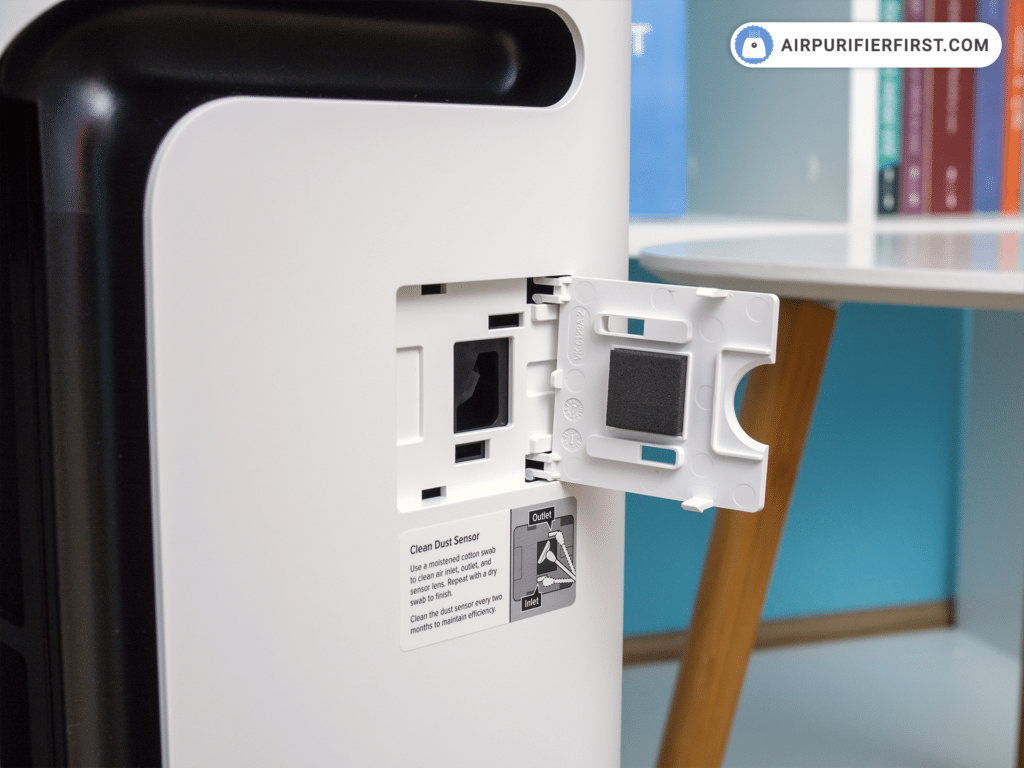
The VeSync app is available for Android and iOS devices.
The Vital 200S uses a three-stage filtration technology, has achieved outstanding results in performance tests, and is both very quiet and easy to maintain. It uses a 50W motor, is very quiet at the lowest speed, and delivers outstanding performance in tests.
Overall, the Levoit Vital 200S isn’t only the best-performing air purifier but also the best smart air purifier you can get.
| Manufacturer | Levoit |
| Model | Vital 200S |
| Dimensions (inches / cm) | 15.6 x 8.5 x 19.8 inches (39,6 x 21,7 x 50,2 cm) |
| Weight (pounds / kg) | 13.2 lb (6 kg) |
| Filtration Technology | Pre-filter, True HEPA Filter, and Activated Carbon Filter |
| Filter Life | up to 12 months |
| Coverage (4.8 ACH) | 380 sq. ft. (35 m²) |
| Number of Fan Speeds | 5 – Sleep Mode, Low, Medium, High, and Turbo |
| Noise Level (low – high) | 41.0 – 62.2 dBA |
| Efficiency Test | 96% in a 320 sq. ft. room |
| Power Consumption | 50W |
| Warranty | 2-year |
| User Manual |
Levoit Vital 200S – Video Review
If you’d rather prefer video content, then our video review of the Levoit Vital 200S is just what you need.
Dyson TP02 – The Most Premium App
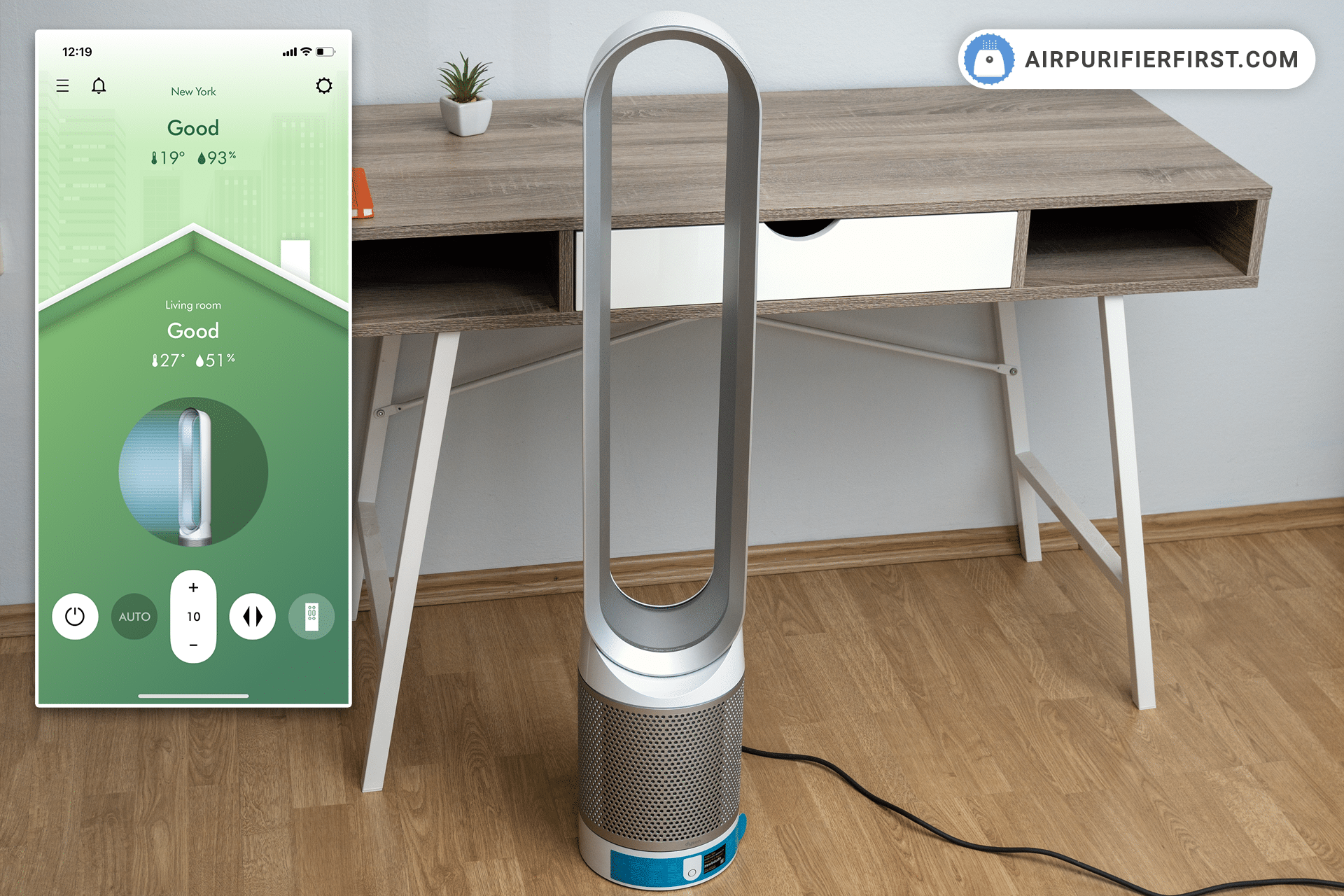
Dyson TP02 Keypoints
- The Dyson TP02 works with the MyDyson smart app, which is available for Android and iOS devices and supports every Dyson smart device, not just air purifiers.
- It features a variety of smart functions, such as an air quality sensor, air quality indicator, auto mode, and smart app integration.
- This air purifier uses one of the most accurate air quality sensors I have seen in an air purifier.
- It covers rooms up to 110 sq. ft. (10 m²), has made an outstanding performance in tests, and uses a motor of just 56W.
- This air purifier comes with a 2-year warranty.
Dyson is known for its innovations across a wide range of devices. Regarding air purifiers, they offer plenty of innovative features such as Air Multiplier technology, advanced filtration technology, and the user-friendly MyDyson smart app.
The Dyson TP02 is one of the best air purifiers Dyson has ever produced. This model is ideal for rooms up to 110 sq. ft. (10 m²) but can also effectively purify slightly larger spaces.
It uses a two-stage filtration technology consisting of a HEPA Glass Filter and an Activated Carbon Filter. The unit has demonstrated outstanding performance in tests and operates very quietly.
This air purifier includes smart features such as an air quality sensor, smart app integration, auto mode, and an air quality indicator. The Dyson TP02 sensor is the best I’ve tested for detecting VOCs, though it should be noted that I’m referring only to sensors built into air purifiers. Standalone air quality monitors/sensors are often of much better quality.
In a performance test in a 120 sq. ft. room, the Dyson TP02 improved air quality by 93%, confirming its effectiveness even in spaces larger than its recommended size.
What also sets the MyDyson smart app apart are its easy controls, strong security, and detailed air quality data reports. However, what I appreciate most is the premium user experience and feel provided by this app. These characteristics make the Dyson TP02 stand out as one of the best smart air purifiers.
| Manufacturer | Dyson |
| Model | TP02 |
| Dimensions | 40 x 4.4 x 7.5 inches (101,6 x 11.2 x 19.1 cm) |
| Weight | 8.4 lb (3.8 kg) |
| Filters | HEPA Glass Filter and Activated Carbon Filter |
| Filter Longevity | about 12 months |
| Room Coverage (4.8 ACH) | 110 sq. ft. (10 m²) |
| Number of Working Modes | 10 – Speed 1, Speed 2, Speed 3, Speed 4, Speed 5, Speed 6, Speed 7, Speed 8, Speed 9, and Speed 10 |
| Power Consumption | 56W |
| Warranty | 2-year |
Dyson TP02 – Video Review
If you’d rather prefer video content, then our video review of the Dyson TP02 is just what you need.
Xiaomi 4 Compact – The Smartest App
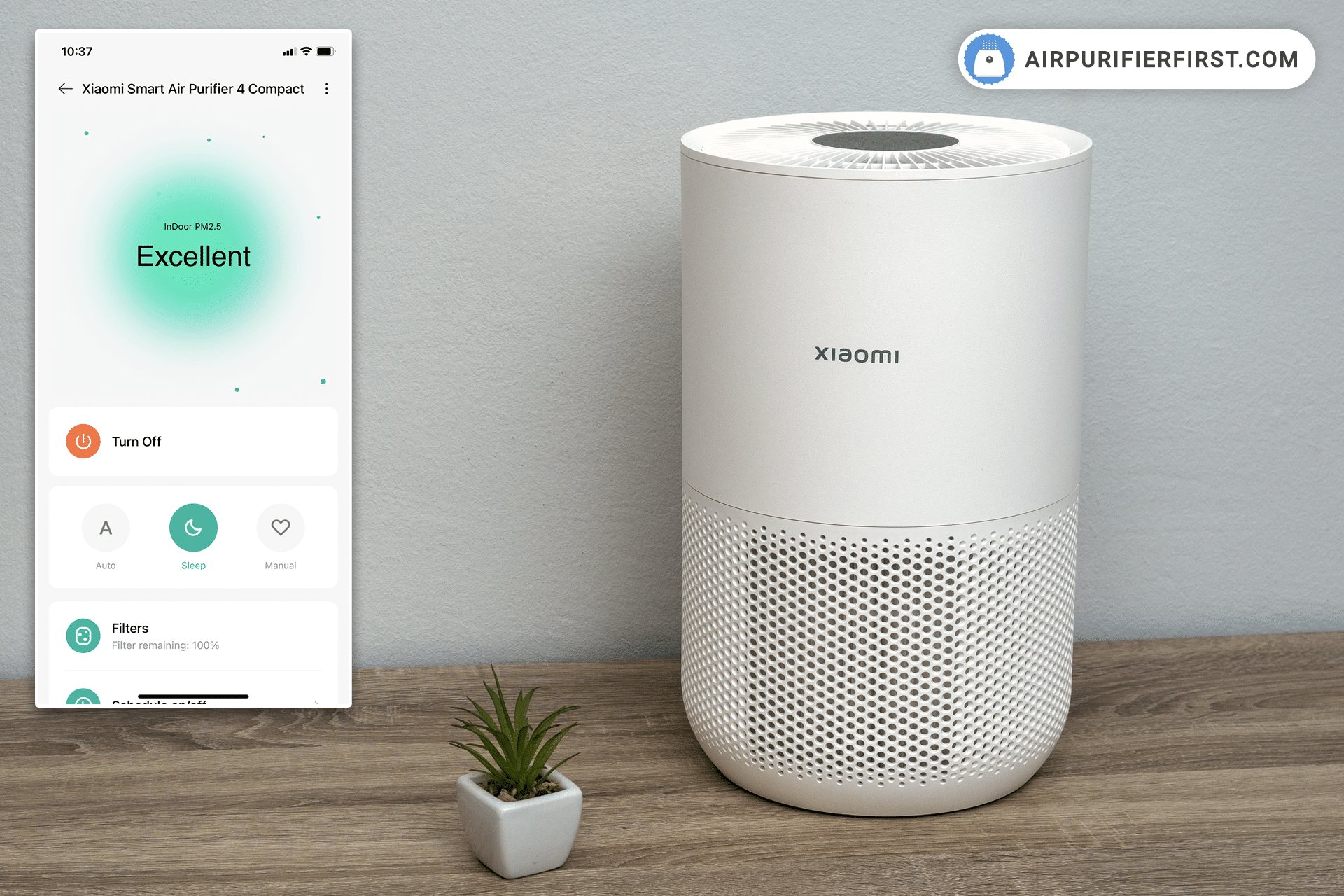
Xiaomi 4 Compact Keypoints
- The Xiaomi 4 Compact is compatible with the Mi Home app, a powerful application that works with all smart Xiaomi devices.
- It features an air quality sensor, air quality indicator, and auto mode.
- This air purifier is suitable for rooms up to 206 sq. ft. (19 m²). It will clean the air 4.8 times in one hour in such a room.
- It improved air quality by 94% in just one hour in a 194 sq. ft. room, while operating at maximum speed for 60 minutes.
- The Xiaomi 4 Compact comes with a 1-year warranty.
Xiaomi produces some great air purifiers, and I have tested a few of them. However, I chose the Xiaomi 4 Compact to put it on my list of best smart air purifiers because it has many characteristics that most people seek, such as portability, a sleek design, and good room coverage.
This small air purifier covers rooms up to 206 sq. ft. (19 m²), uses three-stage filtration technology, and has plenty of smart features.
It’s compatible with the Mi Home smart app, which is an all-in-one app for all Xiaomi devices. Once you have successfully added your Xiaomi 4 Compact to the app, it adapts to your device and activates only the features you need.
What I also like about this air purifier are the air quality sensor, air quality indicator, and auto mode features. However, one thing I want to point out is that this device can’t show its full potential without being connected to the Mi Home app.
All in all, the Xiaomi 4 Compact is a small air purifier with plenty of smart features, ideal for those looking for a compact, smart, and highly effective air purifier.
| Manufacturer | Xiaomi |
| Model | 4 Compact |
| Dimensions | Φ8.6 x 14 inches (Φ22 x 35,5 cm) |
| Weight | 4.8 lb (2.2 kg) |
| Filters | Primary Filter, Xiaomi’s High-Efficiency Filter, and Activated Carbon Filter |
| Filter Longevity | 6-12 months |
| Room Coverage (4.8 ACH) | 206 sq. ft. |
| Number of Working Modes | 3 – Automatic Mode, Sleep Mode, and Manual Mode |
| Power Consumption | 27W |
| Warranty | 1-year |
Xiaomi 4 Compact – Video Review
If you’d rather prefer video content, then our video review of the Xiaomi 4 Compact is just what you need.
Smartmi P1 – With Pollen Detection
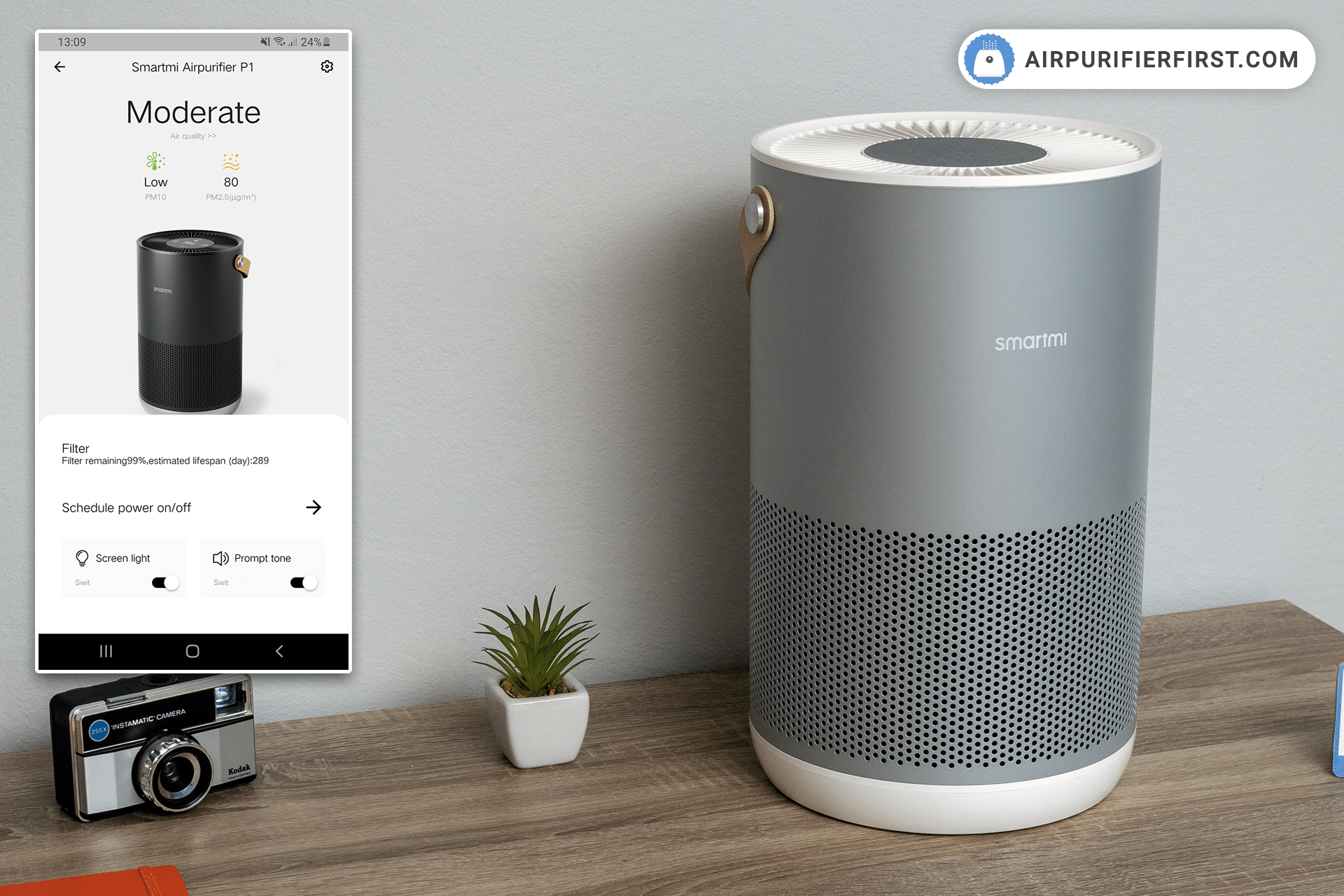
Smartmi P1 Keypoints
- It works with the Smartmi Link app, available on Android and iOS devices.
- The Smartmi P1 features an innovative air quality sensor that detects not only PM2.5 but also pollen (PM10) particles.
- It features three-stage filtration, uses a low-power motor, operates quietly, and is a premium air purifier with excellent build quality.
- The Smartmi P1 made outstanding performance in all tests, especially in the 194 sq. ft. room where it improved air quality by 95% in just 60 minutes.
- It comes with a 1-year warranty.
The Smartmi P1 is very similar to the previously mentioned Xiaomi 4 Compact. Moreover, these two companies are related; based on my research, Smartmi is a sister company of Xiaomi.
This premium air purifier has a high-quality build, and plenty of smart features including an air quality sensor, air quality indicator, auto mode, and a smart app. A unique feature of this model is its ability to detect pollen, not just PM2.5 particles.
It works with the Smartmi Link app, a smart application available for Android and iOS devices, designed exclusively for Smartmi devices. The app unlocks many new features that aren’t accessible through the physical device itself.
The Smartmi P1 is most suitable for rooms up to 320 sq. ft. (30 m²) and can clean the air 4.8 times in one hour in the recommended room sizes.
It uses a three-stage filtration technology consisting of a pre-filter, a True HEPA filter, and an activated carbon filter. In performance tests, in a 320 sq. ft. room, it improved air quality by 91% in just 60 minutes, while operating at maximum speed all the time.
In summary, the Smartmi P1 is an excellent device that is affordable to maintain, equipped with many smart features, and is the one I recommend especially during pollen season due to its innovative pollen detector.
| Manufacturer | Smartmi |
| Model | P1 |
| Dimensions | 8.6 x 14.2 inches (21,8 x 36,1 cm) |
| Filters | Pre-filter, True HEPA Filter, and Carbon-infused Filter |
| Filter Longevity | 6-12 months |
| Coverage | 320 sq. ft. |
| CADR | 250 m3/h |
| Power Consumption | 30W |
| Warranty | 1-year |
Smartmi P1 – Video Review
If you’d rather prefer video content, then our video review of the Smartmi P1 is just what you need.
What Makes an Air Purifier Smart?
A smart air purifier is a device that features an air quality sensor, air quality indicator, auto mode, smart app, and other innovative options.
These air purifiers can be remotely controlled, track air quality in real-time, can be scheduled, automated, and much more.
So, with such a device you won’t only be able to track PM2.5, PM10, or VOCs in your air, but also to make it automatically remove this particle without touching any button or changing any setting.
Did I mention that smart air purifiers usually work with voice-controlled devices such as Alexa, HomeKit, and Google Home?
How Do Smart Air Purifiers Work?
Essentially, smart air purifiers work the same way as traditional air purifiers. Just because an air purifier is smart doesn’t mean it cleans the air in your room better than a regular air purifier. But smart air purifiers may be more energy-efficient (because of auto mode).
They display information about your current air quality and can be programmed to your exact needs. Plus, you can control them from a remote location, at any time, as these devices are mostly connected to your home WiFi.
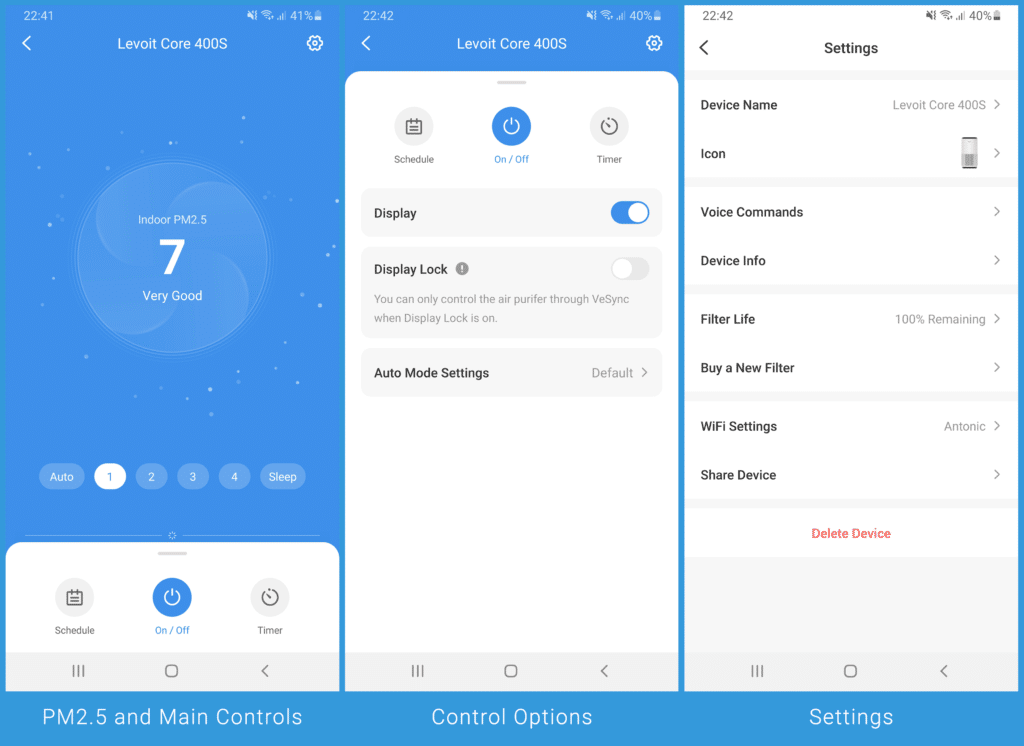
Smart air purifiers work by downloading the manufacturer’s mobile app on your Android or iOS device, launching it, and connecting it to the air purifier. Connecting the app and the device opens up many new possibilities. It gives the device full power and the ability to reach its full potential.
How Do Smart Air Purifiers Detect Air Quality?
Smart apps almost always have an excellent graphical interface that shows, among other things, the current air quality in the room. Given that smart devices mostly have an air quality sensor alongside the app, it is not surprising that apps have this capability. Firstly, it is much easier to read the app’s data and filter it by day than it would be on a screen located on the device itself.
However, many devices have indicators that light up in different colors depending on the air quality and a display that shows the current AQI or the current amount of PM2.5 in the air. The air quality indicator in smart air purifiers usually has a separate motor that draws air in to constantly check the air quality, regardless of the operation of the air purifier. This sensor mostly has lasers that detect the number of particles or VOCs in the air.
Choosing the Best Smart Air Purifier
To choose the best smart air purifier, you first need to decide what kind of air purifier you need. Based on that, select a device on the list of the best smart air purifiers provided in this article. I have indeed chosen all the devices on the list very carefully, and you won’t regret whichever one you choose, but there are some things you need to keep in mind.
The first thing I would recommend is to decide whether you want an air purifier that uses proven filters such as HEPA and carbon filters or whether you still want a slightly different air purifier that uses new, innovative technologies, an ionizer, or UV-C filtration.
In addition, room coverage is critical, so it would be advisable to know how large a room you have and buy an air purifier dedicated to that room size. If you buy a weak air purifier, it could be inadequate and insufficient to clean the air in a room larger than the recommended dimensions.
A final suggestion is to consider the air purifier’s maintenance and filter replacement costs.
In short, if you don’t have a favorite to buy yet, specifying the items I suggested earlier will help you narrow down your choice and make the decision easier. Suppose you still want to do more research. In that case, I recommend you read the individual reviews of these devices on the Air Purifier First website.
Advantages of a Smart Home Air Purifier
Smart air purifiers have many advantages, but there is only one thing that could be a disadvantage: the price, which is slightly higher with smart air purifiers than with conventional ones. However, this type of device has so many advantages that I think most users won’t be bothered by the price.
Real-time air quality: smart air purifiers work in combination with an air quality sensor and display the current air quality in the room at any time on your smartphone, on the screen of the device, or in the form of LED indicators.
Scheduling: almost all smart air purifiers have the option of advanced timer settings. So you can decide when you want the device to turn on or off. However, some of the devices on the list have several additional options, allowing you to fully program the air purifier’s operation.
Additional options: Almost all of the air purifiers I have tested have some hidden options that are only available if they are connected to a smart app. Sometimes these options can only work in the smart app, such as daily air quality charts. It is simply impossible to install so many options and controls on the device itself.
Filter reset indicators: smart devices tend to have much more detailed filter reset indicators, so you can see the current filter wear at any time. For non-smart air purifiers, you don’t have this option, but simply wait for the LED indicator to let you know when it’s time to change the filter.
Voice control: these devices take control to the next level and are technology compliant, so you can easily connect most smart air purifiers to Amazon Alexa and Google Assistant, while some can even connect to Homekit.
Remote control: smart air purifiers have WiFi, so they connect to your home network. This means you can control this type of device from any location, meaning you don’t have to be at home to turn it on or off. You can even check the current air quality in the room through the Internet.
Auto mode: this type of device almost always has an auto mode, which works in combination with the air quality sensor to switch the device’s operating mode according to the current air quality. Is there a better solution for clean and high-quality air than an air purifier with auto mode that you won’t have to lift a finger to operate?
FAQ on Best Smart Air purifiers
Are smart air purifiers a waste of money?
No, they are definitely not. We live in a fast-paced world dominated by technology, and we are used to smart devices that make our lives easier. This idea is also behind the smart air purifier, to display as much information as possible and make the daily use of the device easier.
Can any smart air purifier connect to Alexa?
Whether the manufacturer has made this a feature in the app, the device can easily connect to Alexa, Google Assistant, or even Homekit.
Does every smart air purifier work with HomeKit?
Unfortunately, it doesn’t. To work with the HomeKit, an air purifier must be approved and authorized by Apple. Almost every smart air purifier works with Android and iOS devices, but not necessarily with the HomeKit.
Final Thoughts
If you have read in detail all the suggestions and tips I have written in this review, I doubt you will make a mistake when choosing an air purifier.
However, if you are still in doubt and don’t know which air purifier to choose, my absolute recommendation would be the Levoit Vital 200S, as it is an air purifier that based on all the tests I have done, based on the specifications, features, and capabilities is definitely the best choice to buy.
I think we are all aware of the benefits that smart devices bring, including the air purifiers themselves. I hope that I have also managed to clear all your doubts and point out the obvious advantages of such devices. If you have any questions, please don’t hesitate to ask them in the comments box below. I will be happy to help and answer them.
Leave a Reply